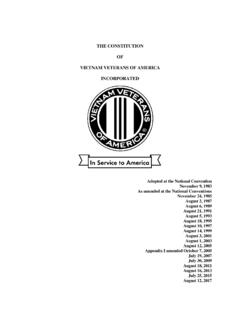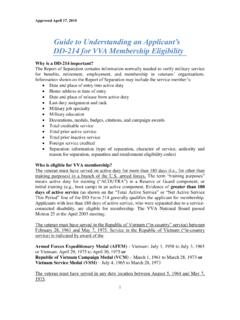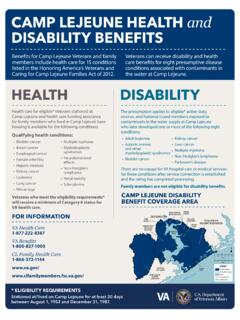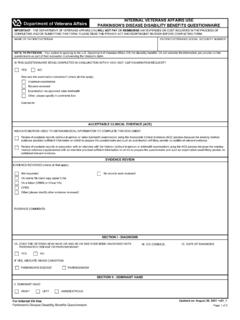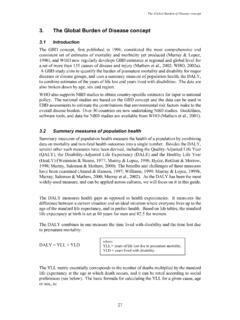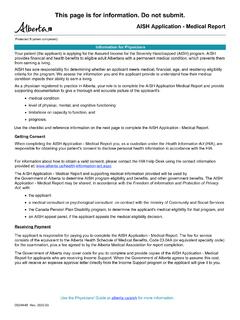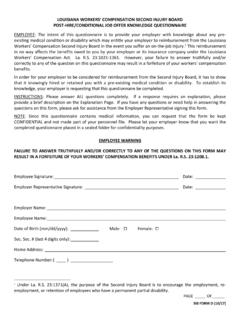Transcription of Service-Connected Disability Compensation For Exposure …
1 Service-Connected Disability Compensation For Exposure To Agent Orangefor Veterans and their familiesthe VVa self-help Guide to may 2016table of ContentsForeword ..1 Introduction ..2 What Is Agent Orange?..3 What Is Presumptive Service-Connected Agent Orange Disability Compensation ? ..6 How Do I Know If I Qualify for Presumptive Service-Connected Agent Orange Disability Compensation ? ..7 What Is the Agent Orange Registry? ..8 How Do I File a Claim with the VA for Presumptive Agent Orange Disability Compensation ? ..10Is Presumptive Service-Connected Agent Orange Disability Compensation Available to Surviving Family Members of a Deceased Vietnam Veteran? ..13Is Presumptive Service-Connected Agent Orange Disability Compensation Available to Biological Children of Vietnam Veterans Born with Certain Birth Defects? ..15Is Presumptive Service-Connected Agent Orange Disability Compensation Available to Incarcerated Vietnam Veterans? ..16 What Other Benefits Are Available to a Vietnam Veteran with an Agent Orange-Related Illness?
2 17 How to File a Claim and What is Intent to File ..18 Veterans Service Organizations ..19 References and Resources ..191 VVA SElF-HElP guIDEA gent Orange is a highly toxic herbicide used by the military during the Vietnam War to defoliate hiding places used by the Viet Cong, rice paddies and fields that provided them with food, and to clear the perimeters of military bases to give service members a clear line of fire. Although colorless, it is known as Agent Orange because of an orange band painted on the drums used to store and transport it. After years of advocacy led by VVA, Congress enacted into law the Agent Orange Act of 1991. This legislation empowered the Secretary of Veterans Affairs to declare certain maladies presumptive to Exposure to Agent Orange/dioxin and enable Vietnam veterans, as well as some veterans who served along the demilitarized zone in Korea in the late 1960s, to receive treatment and Compensation for these health conditions. Service-Connected benefits, however, also may be granted for other maladies not recognized as presumptive health conditions.
3 John RowanNational PresidentVietnam Veterans of America forewordSERVICE- connected Disability Compensation FOR Exposure TO AgENT ORANgE 2 introduCtionthe purpose of this Vietnam Veterans of America (VVA) guide is simple: to present information and describe the process in a user-friendly fashion for a Vietnam veteran or (surviving) family member to file a claim for Service-Connected Disability Compensation or death benefits with the Department of Veterans Affairs (VA) for illnesses/diseases associated with Exposure to Agent Orange and other related herbicides during military service. At the outset, please understand that the VA claims process is complicated, frustrating, and can be time-consuming. Please understand also that these guidelines are not legal hopes this guide will be helpful: If you have never filed a VA claim for Disability or death Compensation because of Exposure to Agent Orange; or If you have filed a VA claim for Disability or death Compensation because of Agent Orange Exposure and it was denied (after all appeals, if any) by the VA before September 25, 1985 (this includes claims or death benefits for Adult Onset Type II Diabetes and ancillary conditions, parkinson s disease , ischemic heart disease , and B-cell leukemias); or If you have filed a VA claim for Disability or death Compensation due to Agent Orange Exposure and it was denied (after all appeals, if any) by the VA on or after September 25, 1985, or if it is still pending.
4 In this situation, do not file a new claim. Contact the appropriate VA Regional Office in writing to confirm and ask the following: 1) whether you filed a claim; 2) what Disability was claimed; 3) whether the claim was based on Agent Orange Exposure ; 4) whether the claim is in the VA s Special Issue Rating System ( , Nehmer) Agent Orange claim; 5) does the VA have your current mailing address; and 6) request a copy of your entire claims file, your C-file ; or If you do not remember 1) whether you ve ever filed a VA claim; or 2) when you filed a VA claim; 3) whether you stated that the Disability or death in your VA claim was due to Agent Orange Exposure ; or 4) you believe you have a medical condition (or the veteran s death was) due to Agent Orange Exposure . In this situation, file a claim as soon as possible, and request a complete copy of your C-file from the nearest VA Regional Office. you can find your nearest VA Regional Office here: VVA SElF-HElP guIDEwhat is aGent oranGe?
5 A host of herbicides were used by the military in Vietnam and other Southeast Asian countries to protect American and allied troops by defoliating the dense jungle vegetation hiding enemy positions. The herbicides were named for the color-coded bands on the 55-gallon drums in which they were shipped; examples included Agent Blue, Agent White, and the most extensively used herbicide, Agent Orange. In Vietnam, herbicides were sprayed from fixed wing and rotary aircraft, trucks, and backpack sprayers to clear vegetation around fire bases, landing zones, and along river banks. It is estimated that between 1962 and 1971, almost 11 million gallons of Agent Orange were sprayed in Vietnam, primarily through an aerial spray program code-named Operation Ranch Hand. Agent Orange was also used at military installations and other facilities on and outside of the mainland, including Hawaii and Puerto Rico, as well as Cambodia, Canada, Korea, and Orange is a combination of two com-pounds, 2,4-D and 2,4,5-T, technically known as chlorinated phenoxy acids in ester form.
6 The most dangerous element of Agent Orange is a contaminant present in the manufacture of 2,4,5-T; this impurity is known chemically as 2,3,7,8-tetrachlorodibenzo-paradioxin, or more commonly, dioxin. levels of dioxin in Agent Orange ranged from less than parts per million to almost 50 parts per three million veterans served in Southeast Asia, and no one knows for sure how many of these veterans were exposed to Agent Orange. Some of these personnel were deployed in areas during and immediately after spraying operations, while others actually handled Agent Orange and did the spraying. Veterans exposed to Agent Orange and its dioxin contaminants have reported a variety of serious health problems and symptoms; these include chloracne, skin lesions, liver damage, loss of sex drive, changes in skin pigmentation and sensitivity to light, numbing or tingling in the extremities, sore joints, cancers, and birth defects in their an incomplete list of locations and dates where dioxin (Agent Orange and other agents) was used, consult the links on the VA web page online at In Vietnam, herbicides were sprayed from fixed wing and rotary aircraft, trucks, and backpack sprayers to clear vegetation around fire bases, landing zones, and along river Disability Compensation FOR Exposure TO AgENT ORANgE 4 Illnesses/dIseases RecognIzed by the Va as connected to agent oRange heRbIcIde exposuReacute peripheral neuropathy: a tempo-rary dysfunction of the nervous system characterized by involuntary tingling or numbness in the extremitiesadult onset type II diabetes Mellitus (and subsequent complications caused by).
7 Non-insulin dependent and charac-terized by high blood sugarsal amyloidosis: a rare group of dis-eases that results from the abnormal deposition of a particular protein called amyloid in various tissues of the body *chloracne: an acne-like eruption on the skin due to prolonged Exposure to certain chlorinated compoundshodgkins disease : a tumor found in the lymph nodes characterized by increas-ing enlargement of the lymph nodes, liver, and spleen, and accompanied by progressive anemiaIschemic (or ischaemic) heart disease : a heart condition resulting when the arteries that bring blood and oxygen to the heart are blocked. There may be a buildup of cholesterol and other sub-stances, called plaque, in the arteries that bring oxygen to heart muscle tis-sue. Over time, the heart muscle does not work well, and it is more difficult for the heart to fill and release blood. It is the most common cause of congestive heart failure. non-hodgkins lymphoma: Non-Hodg-kins lymphoma, including chronic lymphocytic leukemia and small-cell lymphocytic lymphoma: a rare type of cancer which causes malignant tumors of the lymph nodes, distinguished from Hodgkins disease by the absence of giant Reed-Sternberg s disease : a neurological disease limiting the ability to control some muscles.
8 Caused by a gradual loss of dopamine-manufacturing cells in the brain, parkinson s disease often causes movement and muscle problems and may be accompanied by slight, uncontrolled shaking of the arms and legs. *peripheral neuropathy: a dysfunction of the nervous system involving either the somatic nerves or the autonomic nervous system (see Acute Peripheral Neuropathy); can cause sensory loss, atrophy, and muscle weakness *porphyria cutanea tarda: characterized by skin lesions on exposed portions of the body and pigment changes in the skin; liver disease occurs in some patientsspina bifida in children conceived after the veteran first arrived in Vietnam: characterized by a defective closure of the spinal cord in which the cord may be exposed and/or protrudesub-acute peripheral neuropathy: a nervous system disorder either acute (temporary) or chronic (long-term) see acute peripheral neuropathy and peripheral neuropathycanceRs cancer of the bronchus: a malignant tumor found in the bronchus, an extension of the windpipe (trachea) connecting to the lungscancer of the larynx: a malignant tu-mor found in the voice box (larynx)cancer of the lung: a malignant tumor found in the lungscancer of the prostate: a malignant tumor found in the prostate glandcancer of the trachea: a malignant tumor found in the windpipe (trachea)adult Fibrosarcoma: a tumor formed from connective tissuealveolar soft part sarcoma: a sarcoma found in the aveoli, the sac-like ducts in the lungsangiosarcoma.
9 A tumor occurring on the breast and skin and believed to originate from blood vesselschronic lymphocytic leukemia: char-acterized by a progressive increase in production of white blood cellsclear cell sarcoma of aponeuroses: a sarcoma found at the end of a muscle where it becomes a tendonclear cell sarcoma of tendons: a sarcoma found in the tendonscongenital Fibrosarcoma: a malignant tumor formed before birth and derived from connective tissuedermatofibrosarcoma: a relatively slow-growing skin tumor consisting of one or more firm nodulesectomesenchymoma: a tumor found in certain parts of the skinepithelioid Malignant leiomysarcoma: a malignant tumor derived from smooth muscle found in the layer covering the muscleepithelioid Malignant schwannoma: a moderately firm, benign tumor found in the layers of membrane covering surfaces inside the body cavity caused by too many Schwann cells growing in a disorderly mannerepithelioid sarcoma: a tumor found in the membrane covering surfaces inside the body cavityextraskeletal ewing s sarcoma: a tumor outside the bone consisting of small rounded cells5 VVA SElF-HElP guIDEhairy cell leukemia: a rare slow-growing chronic cancer of the blood called such because the leukemic lymphocytes have short, thin projec-tions on their surfaces that look like hairs when examined under a microscope.
10 Hairy cell leukemia is caused by an abnormal change in B lymphocytes (a type of white cell). hemangiosarcoma: a tumor derived from blood vessels and lining blood-filled spacesInfantile Fibrosarcoma: a tumor formed as a child derived from fibrous connective tissueleiomyosarcoma: a tumor derived from smooth muscleliposarcoma: a tumor that may occur anywhere in the body consisting of irregular fat cellslymphangiosarcoma: a tumor derived from blood vesselslymphoma: a malignant tumor of the lymph nodesMalignant Fibrous histiocytoma: a type of tumor found in connective tissueMalignant giant cell tumor of the tendon sheath: a tumor found in the membrane of tendonsMalignant glandular schwannoma: a moderately firm malignant tumor in the glands caused by too many Schwann cells growing in a disorderly patternMalignant glomus tumor: a tumor found in the tiny nodes (glomuli) in the the nailbed, pads of fingers, toes, ears, hands, feet, and other body organsMalignant hemangiopericytoma: a tu-mor characterized by rapidly growing fat cells formed in blood vessels and lining blood-filled spacesMalignant Mesenchymoma: a malig-nant tumor in the embryonic tissue or fluidMalignant shwannoma with Rhabdo-myoblastic: a moderately firm malig-nant tumor found in skeletal muscle resulting from the rapid disorderly growth pattern of Schwann cellsMultiple Myeloma: cancer of specific bone marrow cells characterized by bone marrow tumors in the skeletal systemproliferating angiedotheliomatosis: increasing numbers of benign tumors in blood cells often causing skin discolorationRhabdomysarcoma: tumors derived from skeletal musclesarcoma: tumors arising in connec-tive tissue, bone, cartilage, or musclesoft tissue sarcoma: a group of soft tissue cancers characterized by malignant tumors which develop on muscles and connective tissue, or in body fatsynovial sarcoma.
